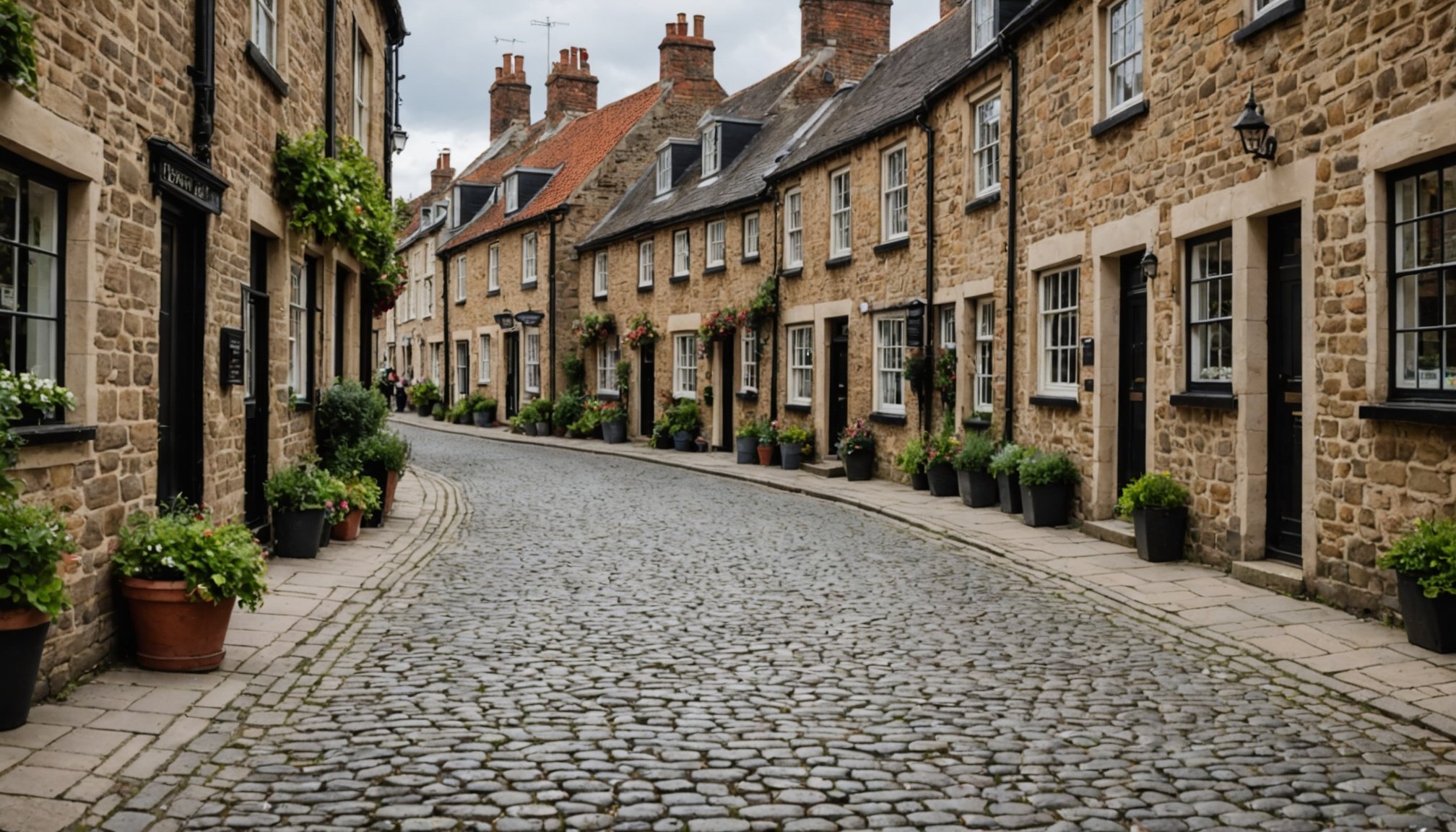Understanding Cobblestone Terrain
Cobblestone streets are a hallmark of many charming towns, offering a quaint and picturesque setting. However, their uneven surfaces can pose significant challenges for pedestrians. These age-old pathways often consist of stones of varying sizes and heights, creating an unpredictable walking surface. The historic aesthetic they provide is enchanting, but navigating them requires careful attention to one’s walking techniques.
Walking on cobblestones demands adaptation. Unlike flat pavements, cobblestone paths can unsettle the usual rhythm of a stroll. One might lean slightly forward, using shorter steps for better balance. These techniques help minimize the risk of ankle twists and falls. Pivoting carefully when turning is also advisable to maintain stability.
Have you seen this : Discover the UK’s Leading Sustainable Footwear Brands You Shouldn’t Miss
Such terrain underscores the importance of adapting walking techniques to suit the surface. Implementing these techniques can ease the experience and reduce potential strain on joints. For those planning to explore towns with such historical streets, practising these methods is a wise strategy. This adaptability not only enhances the walking experience but ensures safety and comfort, allowing visitors to focus on the wonders these beautiful locations have to offer.
Selecting the Right Heel Height
Choosing the right heel height is crucial when traversing uneven surfaces like cobblestone streets. For optimal balance, experts recommend a heel height of no more than two inches. This height provides adequate stability while allowing for some elevation that many find stylish and comfortable. Wearing high heels on cobbled paths can lead to instability, increasing the risk of trips and falls due to the deceptive ground texture.
Comfort should be a top priority in footwear selection. It’s wise to consider your travel plans when deciding on heel height. If your itinerary involves extensive walking through quaint towns with charmingly unpredictable terrains, opting for lower heels or even flat shoes can enhance your comfort significantly.
Personal preferences play a role, too. While some may prioritize style, others should focus on comfort and practicality. Assess your ability to maintain balance and comfort with previously worn shoes. Incorporate these insights into your choices, especially when navigating adventure-filled paths. Travelling should blend enjoyment with safety, and finding the right heel height is a vital step in achieving both. Balancing aesthetics, practicality, and personal preferences can ensure an enjoyable exploration experience.
Choosing Suitable Materials for Footwear
Choosing the right shoe materials can significantly affect your comfort and overall experience while strolling on cobblestone streets. Key factors to consider include breathability and flexibility, which contribute to foot comfort and support. As you navigate these uneven surfaces, crafted footwear materials can enhance your walking experience.
Footwear should ideally be crafted from materials that offer breathability, such as mesh or lightweight fabrics. These allow air circulation, preventing your feet from overheating during lengthy explorations. Additionally, flexible materials ensure that the shoes adapt to the irregular cobblestone terrain, allowing for natural foot movement.
Different types of shoes offer varying levels of comfort and adaptability on cobblestones. Boots often provide excellent support and protection, making them suitable for cooler climates or more challenging walks. Sneakers, on the other hand, often combine breathability and flexibility, making them ideal for warmer weather. Conversely, sandals may offer flexibility and ease but might lack protection and support.
Selecting footwear that marries breathability and flexibility ensures both comfort and practicality. While the shoe type can also depend on weather conditions and personal style, prioritizing appropriate materials can make your cobblestone walking adventure considerably more enjoyable.
Prioritizing Arch Support and Cushioning
When walking on cobblestone streets, the importance of proper arch support and cushioning cannot be overstated. These features are crucial for maintaining foot health and comfort over such uneven terrains. Proper arch support ensures that the entire foot is engaged evenly, distributing pressure more effectively and preventing strain-related injuries.
Different types of cushioning work wonders in absorbing the shock that comes with the unpredictable nature of cobblestones. Gel-based insoles, memory foam, and air-cushioned soles are popular choices as they provide additional comfort and support. These materials help reduce the impact on joints, thereby mitigating the potential for discomfort during prolonged walking sessions.
Footwear that boasts enhanced support features generally includes solid arch support combined with ample cushioning. Such shoes are ideal for cobblestone walking, offering the stability needed to safely navigate these historic paths. Sandals with reinforced arches or sneakers with extra padding can be great choices for tackling these terrains.
Choosing shoes that prioritise arch support and cushioning helps ensure a more comfortable exploration experience. By focusing on these features, you can enjoy enchanting cobblestone streets without compromising on safety or foot health.
Recommended Footwear for Cobblestone Walking
Selecting the right footwear for cobblestone streets can make your journey both comfortable and stylish. When it comes to the best footwear, various brands and models stand out due to their superior design and functionality. They provide necessary features like flexibility, support, and durability, tailored to handle uneven surfaces.
Brands like Ecco and Merrell are often praised for their quality materials and ergonomic design, offering exceptional ankle support and cushioning. Shoes from these brands prioritize comfort without compromising on style, making them ideal for navigating cobbled paths.
When choosing travel shoes, evaluate both functionality and aesthetics. Consider shoes with non-slip outsoles to heighten grip on slippery stones. Moreover, some shoe models incorporate waterproof features, perfect for the unpredictable UK weather.
User reviews frequently highlight comfort, ease of walking, and durability. Stories of reliable performance during extended travels suggest these models could enhance your trip.
Ultimately, investing in the right pair of travel shoes elevates your exploration experience on cobblestone streets. Prioritize brands known for quality and practicality while ensuring they match your style preferences. This balance is key to enjoying both the journey’s path and its stunning destinations.
Exploring Popular Charming Towns
The United Kingdom is home to many charming towns, each offering unique attractions and the quintessential experience of cobblestone streets. These historical paths create a magical backdrop while you explore picturesque locales.
Bibury, often dubbed England’s prettiest village, enchants with its stone cottages and rolling countryside. Walking down its cobblestone pathways, visitors can explore the famous Arlington Row. The Cairngorms National Park encompasses several charming towns offering delightful cobbled streets. Towns like Braemar and Ballater provide a scenic retreat with plenty of history to explore. York boasts a rich heritage with its medieval streets, including the well-preserved The Shambles.
To fully enjoy these cobblestone streets, ensure you have the right gear. Wearing flats or low heels will help maintain balance, while shoes with adequate arch support and cushioning ensure comfort during exploration. Moreover, choose footwear made from breathable and flexible materials to accommodate the uneven terrain.
When visiting these charming towns, take time to savour local attractions such as historic landmarks, cosy tea rooms, and scenic walks. Plan your exploration to move leisurely, appreciating the unique architecture and cultural tapestry that characterise these destinations.











